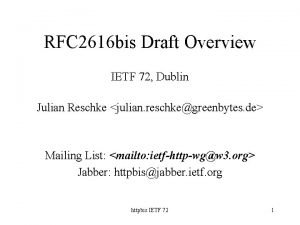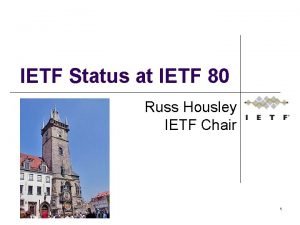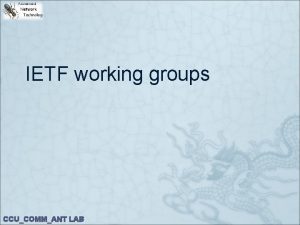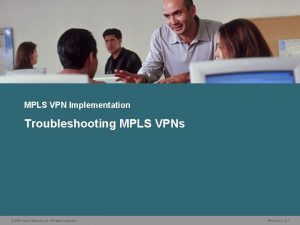IETF 86 Framework for PointtoMultipoint MPLS TP drafthmkmplstpp









- Slides: 9

IETF 86 Framework for Point-to-Multipoint MPLS -TP draft-hmk-mpls-tp-p 2 mp-oam-framework-02. txt March 11, 2013 Yoshinori Koike Takafumi Hamano Masatoshi Namiki

Background Ø P 2 MP becomes increasingly important in terms of energy efficiency and efficient network resource usage. Ø draft-fbb-mpls-tp-p 2 mp-framework will be summary of all features of MPLS-TP P 2 MP transport path

Motivation • Develop this document to see and study if additional detailed requirements and framework in parallel with draft-fbb-mpls-tpp 2 mp-framework • This draft covers OAM related framework including management of MPLS-TP P 2 MP transport paths.

Main updates from -01 to -02 1) Clarified requested scenario of M-leaves monitoring 2) Described MPLS-TP P 2 MP requirements and frameworks that need to be modified in RFC 5860 and RFC 6371 3) Added a requirement that needs to be considered when one or more leaves are added to an existing p 2 mp transport path.

1) M-leaves monitoring scenario Scenario 2 is the most efficient and reasonable approach in terms of bandwidth consumption and transport experiences. Scenario 1: OAM protocol based (not supported in RFC 6371) Scenario 2: Sink MEP based Scenario 3: EMS based Scenario 4: NMS based NMS NMS EMS EMS Pre-configuration Notification

1) M-leaves monitoring scenario (Contd. ) Characteristics of M-leaves monitoring scenario in case of extension from a current function for sending an OAM packet to all leaves Scenario 1 Scenario 2 Scenario 3 Scenario 4 OAM protocol YES extension NO NO NO NE configuration NO YES NO NO EMS configuration NO YES NO NMS configuration NO YES YES Remarks Not supported in RFC 6371

2) Refinement of P 2 MP requirements (RFC 5860) Current text: The MPLS-TP OAM toolset MUST provide a function to enable an End Point to determine whether or not it is connected to specific End Point(s) by means of the expected PW, LSP, or Section. Proposed text: The MPLS-TP OAM toolset MUST provide a function to enable a sink End Point to determine whether or not it is connected to a specific source End Point by means of the expected PW or LSP. (RFC 6371) Current text: Proactive Continuity Check functions, as required in Section 2. 2. 2 of RFC 5860 [11], are used to detect a loss of continuity (LOC) defect between two MEPs in an MEG. Proactive Connectivity Verification functions, as required in Section 2. 2. 3 of RFC 5860 [11], are used to detect an unexpected connectivity defect between two MEGs (e. g. , mismerging or misconnection), as well as unexpected connectivity within the MEG with an unexpected MEP. Proposed text: Proactive Continuity Check functions, as required in Section 2. 2. 2 of RFC 5860, are used to detect a loss of continuity (LOC) defect from the source MEP to sink MEP(s). Proactive Connectivity Verification functions, as required in Section 2. 2. 3 of RFC 5860, are used to detect an unexpected connectivity defect from the source MEP to sink MEP(s) (e. g. , mismerging or misconnection), as well as unexpected connectivity within MEG with an unexpected source MEP.

3) Additional requirement 9. OAM functions of a newly added/deleted branch transport path from any point of an existing transport path must be able to be configured and enabled/disabled on a newly integrated/combined P 2 MP transport path without affecting client traffic to existing end points of the P 2 MP transport path other than the added/removed branch transport path.

Next steps • Solicit comments on general aspects of OAM requirements in P 2 MP transport path • Study and develop requirements related to addition/removal of a branch leaf/tree • Describe each OAM function in P 2 MP transport path respectively

















